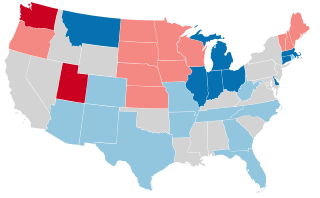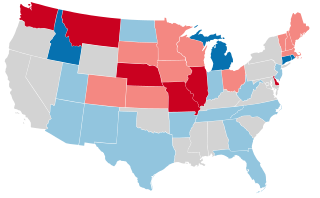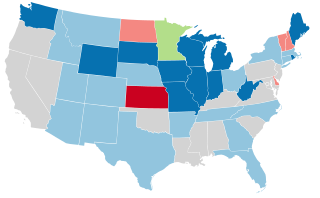
The 1960 United States Senate elections coincided with the election of John F. Kennedy as president on November 8, 1960. The 33 seats of Class 2 were contested in regular elections. A special election was also held on June 28, 1960, for a mid-term vacancy in North Dakota where Democrats flipped a seat to expand their majority to 66–34. As Majority Leader Lyndon Johnson was elected Vice President, Mike Mansfield became the new majority leader.

The 1952 United States Senate elections was an election for the United States Senate which coincided with the election of Dwight D. Eisenhower to the presidency by a large margin. The 32 Senate seats of Class 1 were contested in regular elections, and three special elections were held to fill vacancies. The Republicans took control of the Senate by managing to make a net gain of two seats. However, Wayne Morse (R-OR) became an independent forcing Republicans to rely on Vice President Richard Nixon's tie-breaking vote, although Republicans maintained a 48–47–1 plurality. Wayne Morse would caucus with the Republicans at the start of Congress’ second session on January 6, 1954 to allow the GOP to remain in control of the Senate. This was the third time, as well as second consecutive, in which a sitting Senate leader lost his seat.

The 1932 United States Senate elections coincided with Democrat Franklin D. Roosevelt's landslide victory over incumbent Herbert Hoover in the presidential election. The 32 seats of Class 3 were contested in regular elections, and special elections were held to fill vacancies.

The 1916 United States Senate elections were elections that coincided with the re-election of President Woodrow Wilson. This was the first election since the enactment of the Seventeenth Amendment that all 32 Class 1 senators were selected by direct or popular elections instead of state legislatures. Republicans gained a net of two seats from the Democrats, and then an additional two seats through mid-term vacancies thereby reducing Democrats to a 52–44 majority.

The 1944 United States Senate elections in Indiana took place on November 7, 1944.

United States gubernatorial elections were held on 8 November 1960, in 27 states. The elections were concurrent with the House elections, the Senate elections and the presidential election.

The 1944 United States Senate election in Maryland was held on November 7, 1944. Incumbent Democratic U.S. Senator Millard Tydings was re-elected to a fourth term in office over Republican Blanchard Randall Jr.

The 1964 United States Senate election in Missouri took place on November 3, 1964. Incumbent Democratic U.S. Senator Stuart Symington was re-elected to a third term in office over Republican Jean Paul Bradshaw.

United States gubernatorial elections were held in 1913, in four states. Massachusetts at this time held gubernatorial elections every year. It would abandon this practice in 1920. New Jersey at this time held gubernatorial elections every 3 years. It would abandon this practice in 1949. Virginia holds its gubernatorial elections in odd numbered years, every 4 years, following the United States presidential election year.

United States gubernatorial elections were held in 1956, in 30 states, concurrent with the House, Senate elections and the presidential election, on November 6, 1956. The special election in Oregon was due to the death of incumbent governor Paul L. Patterson on January 31.

United States gubernatorial elections were held in 1952, in 30 states, concurrent with the House, Senate elections and the presidential election, on November 4, 1952. Elections took place on September 8 in Maine. This was the last 2-year gubernatorial election Tennessee held, as they would switch from 2-year to 4-year terms in 1954.

United States gubernatorial elections were held in 1948, in 33 states, concurrent with the House, Senate elections and presidential election, on November 2, 1948. Elections took place on September 13 in Maine.

United States gubernatorial elections were held in 1940, in 34 states, concurrent with the House, Senate elections and presidential election, on November 5, 1940. Elections took place on September 9 in Maine.

United States gubernatorial elections were held in 1936, in 34 states, concurrent with the House, Senate elections and presidential election, on November 3, 1936. Elections took place on September 14 in Maine.

United States gubernatorial elections were held in 1932, in 35 states, concurrent with the House, Senate elections and presidential election, on November 8, 1932. Elections took place on September 12 in Maine.

United States gubernatorial elections were held in 1928, in 35 states, concurrent with the House, Senate elections and presidential election, on November 6, 1928. Elections took place on September 10 in Maine.

United States gubernatorial elections were held in 1926, in 33 states, concurrent with the House and Senate elections, on November 2, 1926. Elections took place on October 5 in Arkansas, and September 13 in Maine.

United States gubernatorial elections were held in 1924, in 36 states, concurrent with the House, Senate elections and presidential election, on November 4, 1924. Elections took place on October 7, 1924 in Arkansas, and September 8, 1924 in Maine.

United States gubernatorial elections were held in 1920, in 35 states, concurrent with the House, Senate elections and presidential election, on November 2, 1920. Elections took place on September 13 in Maine.

United States gubernatorial elections were held in 1916, in 36 states, concurrent with the House, Senate elections and presidential election, on November 7, 1916. Elections took place on September 11 in Maine.




















